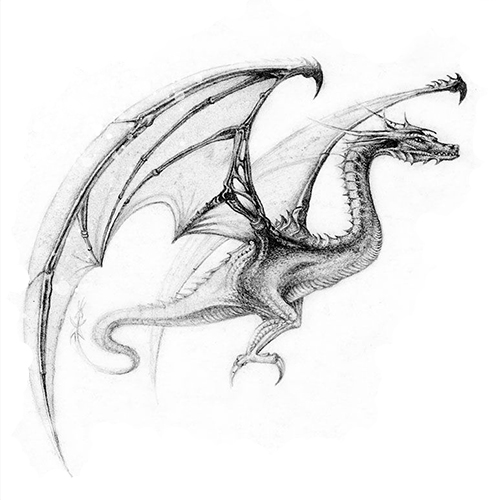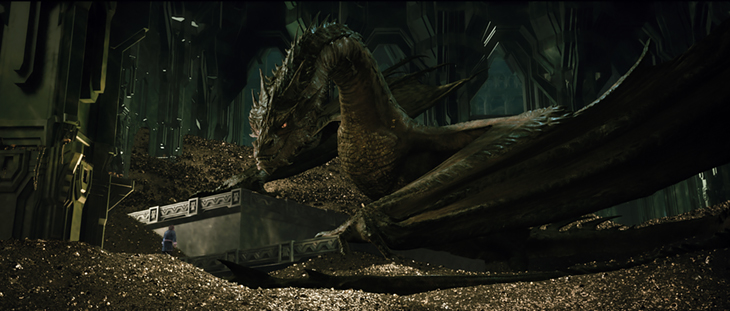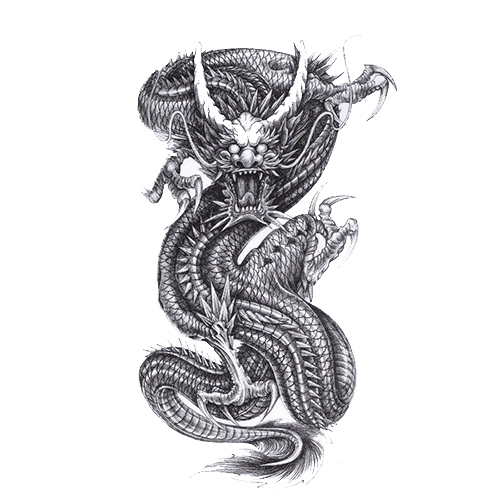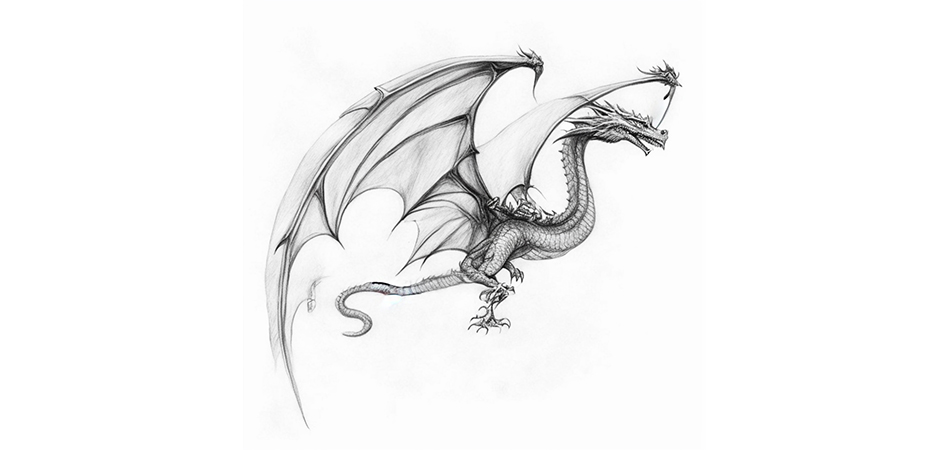As one of the most popular mythological creatures in modern day, the dragon is no mystery. It does, however, have a lengthy history that many people are unaware of. When most people envision a dragon, they think of a large reptile-like creature with enormous wings that breathes fire and attacks castles.
Although dragons (or dragon-like creatures) occur commonly in legends around the world, different cultures have perceived them differently. Chinese dragons, and Eastern dragons generally, are usually seen as benevolent and spiritual, representative of primal forces of nature and the universe, and great sources of wisdom. In contrast, European dragons, as well as some cultures of Asia Minor such as the ancient Persian Empire, were more often than not malevolent, associated with evil supernatural forces and the natural enemy of humanity.
Dragons in the west and Christianity
The most ancient traditions about dragons go back to the Sumerian, Akkadian, and Egyptian mythologies of the first three millennia bce. In these contexts dragons (often clearly serpentine; in some cases, as in that of Tiamat, of different, though unclear, shapes) represent forces or elements that interfere with the correct order or functioning of the world, and they are vanquished by gods who shape and organize the cosmos and, through their victory, acquire authority and power over the newly ordered world.

In general, in the Middle Eastern world, where snakes are large and deadly, the serpent or dragon was symbolic of the principle of evil. Thus, the Egyptian god Apepi, for example, was the great serpent of the world of darkness. But the Greeks and Romans, though accepting the Middle Eastern idea of the serpent as an evil power, also at times conceived the drakontes as beneficent powers—sharp-eyed dwellers in the inner parts of the Earth. On the whole, however, the evil reputation of dragons was the stronger, and in Europe it outlived the other. Christianity confused the ancient benevolent and malevolent serpent deities in a common condemnation. In Christian art the dragon came to be symbolic of sin and paganism and, as such, was depicted prostrate beneath the heels of saints and martyrs.
In the new Christian context, numerous hagiographic and other traditions contained a restructured version of the ancient mythical theme of the battle against the dragon or monster, in which the dragon was an embodiment or an emissary of Satan. The best-known type of battle between a holy being and the devilish dragon in Christian traditions opposes the satanic enemy to a warrior figure. One might mention Saint George, a saintly knight of Anatolian origin, who often replaced the “pagan” dragon slayers of local, pre-Christian traditions; or Michael, the Archangel, an important figure of Christian angelology that is presented as a dragon slayer already in the earliest texts (Rv. 12:7–9). These two figures are extremely popular in Christian iconography from the earliest times; they are usually shown dispatching the satanic dragon with a lance or sword, clad in full armor, and Saint George is often depicted on horseback.
Dragons | Treasure guardians

The tradition of the dragon as a greedy usurper, robber, devourer, or withholder may be combined with two other widespread motifs: the theme of the serpent who in primeval times deprived humankind of immortality—a theme attested, for example, in the biblical Book of Genesis (3:1–15) and in the Mesopotamian Epic of Gilgamesh— and the widespread theme, which is especially important in many Asian mythologies, of the snake that resides at the foot of the tree of life or the cosmic tree.
Such combinations probably gave rise to the theme of the dragon as a custodian of the tree of life or of other sources of immortality or longevity: one should quote the ancient Greek myth of the dragon that guarded the golden apples of the Hesperides, killed by Herakles when the hero conquered the apples, or the nāga s of Indic tradition, that guarded the White Mountain and its wonder-tree Mahāsankha, “tall as Mount Meru,” that produced a special fruit. In other cases the dragon is shown not guarding but attacking the holy tree: thus, in Iranian mythology (Bundahishn 18.2) the reptile created by Ahriman that damages the miraculous plant Gayo-kerena, or, in Germanic traditions, the serpent Níðho̜ggr that attacks the roots of the cosmic tree Yggdrasill.
The theme of the dragon as guardian of the tree of life or cosmic tree is connected typologically to the theme of the dragon who guards treasures, widely attested in China, India, and Europe. See, for instance, the ancient Greek tradition about the dragon that guarded the Golden Fleece and was killed by the hero Jason, who thus obtained the precious token of kingship; the serpents guarding the gold of Apollo among the Scythians (Herodotus, 3.116); and the Germanic myth of the snake Fafnir who guards the gold coveted by Regin and is killed by the hero Sigurd. The theme of the dragon guarding the tree of life became an important iconographical motif in ancient and medieval art of Asia and Europe: it is found, in a rigid heraldic scheme, even in the reliefs of the Baptistery of Parma and of other medieval churches.
Dragons as protectors
In spite of the systematic “demonization” of dragon figures in the Christian Middle Ages, specialists of European folklore and medieval culture have shown that many aspects of the dragon lore of Europe point to a more complex symbolic and mythical value of dragons. It will suffice here to quote the heraldic use of dragons in crests, banners, and insignia, from late antiquity to modern times; the identification (that has been compared to “totemic” practices of tribal societies) of nations and lineages with dragons; the presence of dragons (often as symbols of fecundity and prosperity) in liturgical processions (such as the Rogations of western Europe) or in folkloric festivals (such as Carnival).
The “positive” traits of dragons in European traditions show the dragon lore of Europe to be polysemous. They may be usefully compared to the “positive” traits of dragons in East Asia, and especially in China, where dragon figures are no less polysemous than in the Western tradition.
The dragon’s form varied from the earliest times. The Chaldean dragon Tiamat had four legs, a scaly body, and wings, whereas the biblical dragon of Revelation, “the old serpent,” was many-headed like the Greek Hydra. Because they not only possessed both protective and terror-inspiring qualities but also had decorative effigies, dragons were early used as warlike emblems. Thus, in the Iliad, King Agamemnon had on his shield a blue three-headed snake, just as the Norse warriors in later times painted dragons on their shields and carved dragons’ heads on the prows of their ships. In England before the Norman Conquest, the dragon was chief among the royal ensigns in war, having been instituted as such by Uther Pendragon, father of King Arthur. In the 20th century the dragon was officially incorporated in the armorial bearings of the prince of Wales.
Dragons of Slavic mythology, known as zmeys (Russian), smok (Belarussian), zmiy (Ukrainian), are generally seen as protectors of crops and fertility. They tend to be three headed, conglomerates of snakes, humans, and birds, they are never bound to one form and often shape shift. They are however, often portrayed as male, and seen as sexually aggressive, often mating with humans. They are associated with fire and water, as both are crucial for human survival. In Slavic mythology the dragon doesn’t always represent something bad. The best example of this is the Slovenian dragon of Ljubljana, who benevolently protects the city of Ljubljana and is pictured in the city’s coat of arms.
Dragons in the East
In the Far East, the dragon managed to retain its prestige and is known as a beneficent creature. The Chinese dragon, lung, represented yang, the principle of heaven, activity, and maleness in the yin-yang of Chinese cosmology. From ancient times, it was the emblem of the Imperial family, and until the founding of the republic (1911) the dragon adorned the Chinese flag. The dragon came to Japan with much of the rest of Chinese culture, and there (as ryū or tatsu) it became capable of changing its size at will, even to the point of becoming invisible. Both Chinese and Japanese dragons, though regarded as powers of the air, are usually wingless. They are among the deified forces of nature in Taoism.
The connection of Chinese dragons with rain is well exemplified by the ritual practices of ancient China; during droughts, images of the Ying dragon, a water figure, were made, to propitiate rainfall. Yet dragons are also important in rituals of cosmic renewal, as is shown by the presence of dragon masks during the lamplit, nightly festivities that close the Chinese New Year feast; and many traditions and practices point to the other value of dragons as symbols of cosmic rhythm. In particular, this is clear in the symbolic correspondences and ties between dragons and the Chinese emperors or Sons of Heaven who were also representative of cosmic rhythms and givers of fecundity. Thus we are told that an emperor of the Hsia dynasty ate dragons in order to ensure magically the welfare of his kingdom, and that when that same dynasty underwent a crisis and lost its vital force, dragons appeared to reestablish the correct rhythmic flux in various ways.

Finally, mythical dragons were responsible for the ascension of monarchs to the heavenly regions, as happened, we are told, when Huangdi, the Yellow Emperor, was abducted with several members of his court by a bearded dragon and carried to the sky.
Throughout Southeast Asia, in South India, Indochina, and Indonesia, dragons are water figures and symbols of fertility. This is attested not only by narrative traditions but also by ritual practices. Thus, in modern Cambodian weddings the bride is identified with the moon, her teeth are treated as if to deprive them of serpent venom, and the rituals are explicitly connected with myths about a dragonlike royal ancestress; in Tenasserim (Burma), to stop the rainy season and to bring in the dry weather, a statue of Upagutta, a mythical serpent king, is plunged in water and offered sacrificial gifts, in a ritual that is a symmetrical reversal of the Chinese dragon rite mentioned above.
Dragons in the modern world
Over the years dragons have become the most famous and recognizable of all mythical creatures, used repeatedly in fantasy, fairy tales, video-games, film, and role-playing games of pop culture fame. While still seen as powerful and often dangerous to humankind, the latter part of the twentieth century saw a change in attitude, with the good qualities of dragons becoming more prominent. No longer must all dragons be defeated by the hero or saint, some are ready to share their wisdom with human beings and act as companions, friends, and even guardians of children—roles that parallel those of the angels. And by the way, I have hear that all dragons speak Draconic, so maybe if you come across one, you may find this information useful.
Thanks to all sources for this article: encyclopedia.com, newworldencyclopedia.org and britannica.com

